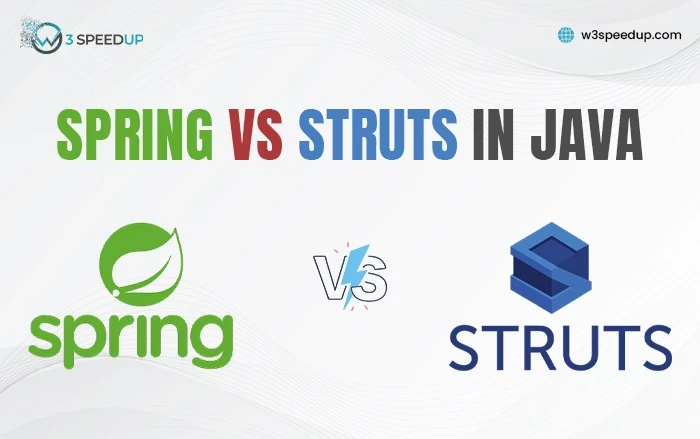Popular programming languages like Java are utilized by 33.27% of developers globally. Since every software developer wants to contribute to the platform, this technology has various frameworks and upgrades.
However, the multiplicity of technology makes choosing one challenging. Let’s discuss the distinctions between Struts and Spring framework.
What’s Spring?
Java framework Spring is open-source. The initial specification did not include dependency injection (DI) or Inversion of Control (IoC). The technology largely simplifies web app development. Spring Framework lets programmers build tested, portable, and modular apps. Spring has its own ecosystem with solutions like Spring Boot, Spring Cloud, Spring Data, Spring Security, and others.
 Pros
Pros
Leading Spring benefits include:
- Lightweight: POJOs are used to construct enterprise-level applications in servlet containers instead of application servers. It cuts expenses and accelerates development.
- Consistent configuration: Developers may choose XML or Java annotations. This keeps software constant and prevents chaos. You receive clean, reusable code for your project.
- Server needs: No web or application server is needed for the framework. Dependency injection manages all components, saving money.
- Reusability: Spring includes several JDK timers and lagging frameworks. Engineers will spend less time writing new code, cutting costs and accelerating development.
- Provided modules: The framework offers numerous classes and packages, so developers may choose to use them. This lets skilled software developers create strong solutions.
❌ Cons
Spring has many major drawbacks:
- Difficulty: The framework is difficult for beginning developers. Because of its unusual programming methodology, only experienced software developers should use it.
- Security: Unfortunately, Spring’s documentation lacks cross-site scripting information. Security is entirely up to the developer.
- Complexity: Junior specialists can hardly handle the technology’s many modules, classes, and variables. You need an experienced staff to succeed.
- Mechanisms parallel: Spring has lots of options, and developers must select the necessary ones. Again, the problem is behind the scenes.
- Knowledge of XML: Developers must be ready to use XML as Spring uses it a lot.
A Spring-savvy java development service can mitigate these drawbacks and help you avoid most issues. Most of it requires skill and caution.
What’s Struts?
Java framework Apache Struts is open-source. It uses the MVC paradigm and offers pre-built classes for developers to edit. The technology is typically used for online apps. Struts simplifies web application creation and maintenance by offering pre-defined functionality. Code expansion, debugging, and comprehension are among its strengths.
 Pros
Pros
Advantages of Struts include:
- Integrations supported: Developers may add any framework or technology to add capabilities to their applications.
- Annotations: The framework simplifies programming using annotations and configuration files.
- High testability: Struts simplifies unit testing and reduces costs by not requiring sophisticated structures like HttpServletResponse or Request.
- Use of OGNL: The framework leverages OGNL to convert ValueStack data and minimize code.
- Simplified ActionForms: POJOs in Struts don’t need class extensions or interfaces. Reduces development time.
❌ Cons
Struts disadvantages include:
- Difficulty: Like Spring, Struts demands a strong awareness of Java pros and disadvantages and a broad background to utilize properly.
- Less transparency: Many operations are happening in the background, making this framework harder to understand.
- Single servlet: Unless the developer discovers a solution, the framework supports just one ActionServlet, limiting scalability.
Like this kind of comparison article? Then you will also like comparing waterfall vs agile.
Spring vs. Struts: 5 Differences
When comparing Struts with Spring, the difference is clear. As with other popular technology, they are comparable in many ways, but here are the significant differences:
- Specialties: Spring combines DI and IOC, Struts expands servlet APIs.
- Architecture: Spring uses layers, whereas Struts does not.
- Framework: Spring is light, but struts are heavy due to tight coupling.
- Integration: Spring offers ORM and JDBC, but Struts needs manual code.
- Flexibility: Spring modules and products are more flexible than Struts.
These concepts define both frameworks’ use cases. These will be covered in the following sections.
 Read More: Five Benefits Of Digital Transformation For Businesses
Read More: Five Benefits Of Digital Transformation For Businesses
 Read More: The Software That Can Save Your Business In 2024
Read More: The Software That Can Save Your Business In 2024
 Christmas Mega Sale – Enjoy Up to 50% OFF on Every Plan!
Christmas Mega Sale – Enjoy Up to 50% OFF on Every Plan! 


